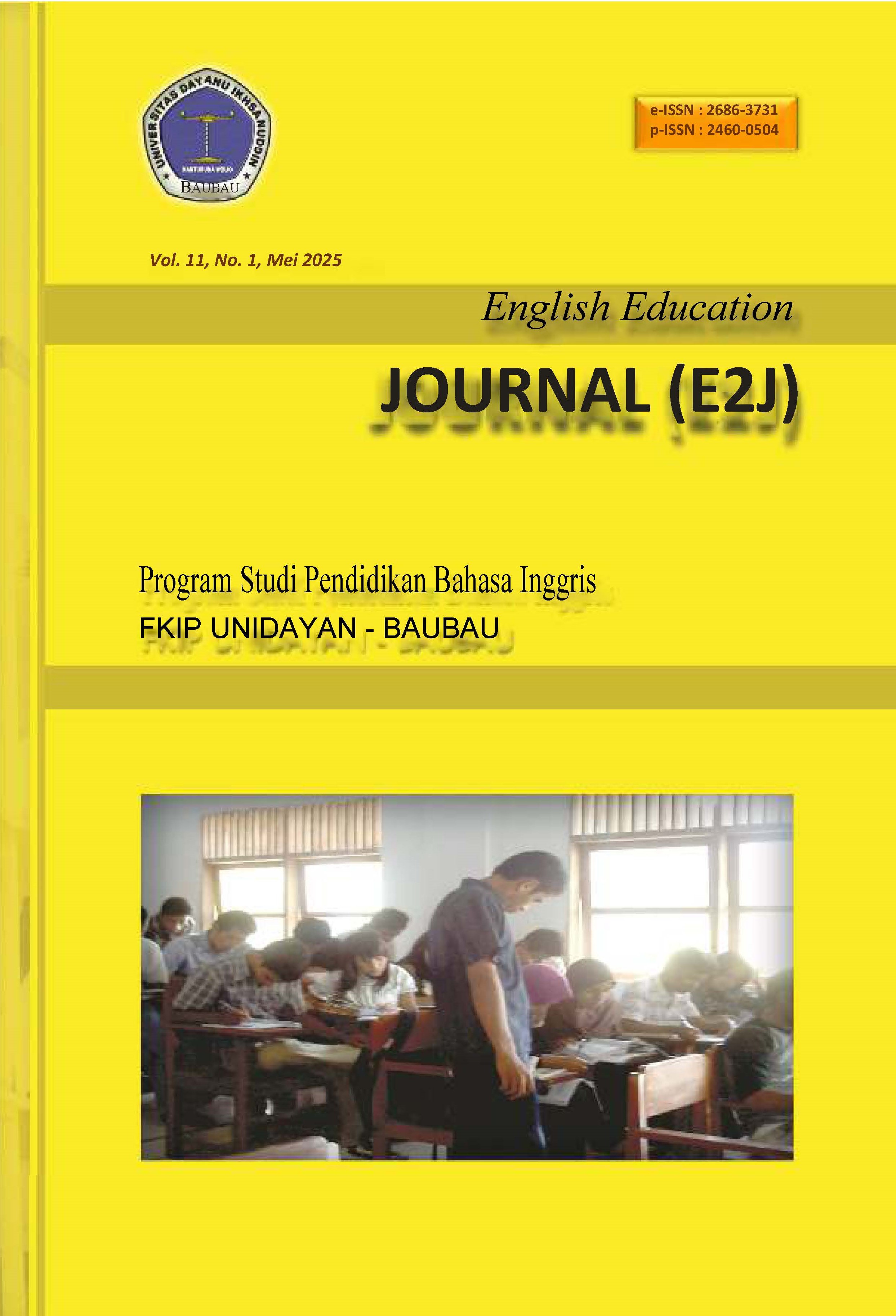INCORPORATING FREE WRITING TECHNIQUE IN ENGLISH CLASS: A CLASS ROOM ACTION RESEARCH TO IMPROVE STUDENTS’ WRITING ABILITY
DOI:
https://doi.org/10.55340/e2j.v11i1.1859Keywords:
Freewriting technique, Teaching Writing, Writing performance, EFLAbstract
This classroom action research aims to assist students overcome their writing problems and enhance the quality of their writing using freewriting technique. Specifically, the research aimed to address two research questions: (1) Is there any improvement on students’ writing quality through the implementation of free writing technique? (2) How is students’ perception toward the implementation of free writing technique? The research was carried out at SMPN 48 Buton during the even semester of academic-year 2023/2024 with 25 participants. The study was conducted in two cycles, with three steps in each cycle: preparation, implementation, and observation. Writing tests were applied to collect data on students’ writing performance, and students’ perceptions toward the application of freewriting technique were gathered through interview. The data were analyzed quantitatively and qualitatively. The results of the research shows that: (1) students’ writing quality is successful to be improved in two cycles of the implementation of freewriting technique, and (2) in general, students regard that their writing quality improve since freewriting technique is motivated, and the techique is also effective to reduce their writing anxiety. This implies that freewriting technique is significantly effective to improve students’ writing quality.
Downloads
References
Elbow, Peter. (2000). Everyone Can Write. Oxford University Press.
Nunan, D. (2014). Task-Based Language Teaching. Cambridge University Press.
Demneri, E. (2024). Students’ Difficulties in Writing in English Language. Proceedings of the International Conference on Modern Research in Education, Teaching and Learning, 3(1), 35-41. https://doi.org/10.33422/icmetl.v3i1.290
Alisha, F., Safitri, N. & Santoso, I. . (2019). Students’ Difficulties in Writing EFL. Project, 2(1), 20-25.
Byrne, D. (2021). Teaching Writing Skills. Longman.
Gardner, R. (2018) Designing Writing Assignments. Illinois, Urbana: National Council of Teachers of English.
Schneider, P. (2011). Writing Alone and with Others. Oxford University Press.
White, R. (2081) Process Writing.Longman
Budjalemba, AS. & Listyani. (2020). Factors Contributing to Students’ Difficulties in Academic Writing Class: Students’ Perceptions. UC Journal, 1(2), 135-149.
Dewi, SM, Suhartini, L. & Muhsin, MK. (2021). The Effect of Free Writing Technique on Students’ Writing Skills at SMA Negeri 6 Kendari. Journal of Teaching of English, 6(4), 418-424.
Penn, S. & Lim, HW. (2016) “The effect of freewriting exercises on adult Korean students’ English learning” The Journal of Asia TEFL, Vol 13, No. 4, Winter 2016, 313- 330.
Rivers, W. M and Temperley, M. S. 2007. A Practical Guide to the Teaching of English as Second or Foreign Language. New York: Oxford University Press.
Scott, W.A. & Ytreberg, L. H. (2002) Teaching English to Children. Longman.
Raimes, A. (2019). Techniques in Teaching Writing. Oxford: OUP
. Heffernan, J AW. & Lincoln, JE. 2010. Writing: A College Handbook. Norton & Company.
. Harmer, J. (2022). How to Teach English. Pearson Longman.
Rao, Z. (2007). Training in brainstorming and developing writing skills. ELT Journal, 61 (2).
Ferris, DR. & Hedgcock, JS. (2011). Teaching ESL Composition. Lawrence Erlbaum Associates.
Cole, AL. (2001). The Thesis Journey: Travelling with Charley. Brock Education. 13 (1): 1–13. Retrieved 2024-07-02.
Goldberg, N. (1986).Writing down theBones: Freeing the Writer within. https://www.eric.ed.gov/?id=ED410590. Retrieved 2024-05-26.
Kemmis, S, & McTaggrat, R. (2010) The Action Research Planner. Victoria: Deakin University.
Li, LY. (2007) Exploring the Use of Focused Free Writing in Developing Academic Writing, Journal of University Teaching and Learning Practice, 4(1).40-53. University of Canberra. http://ro.uow.edu.au/jutlp/vol4/iss1/5/
Rosenberg, VM. (1989) Reading, Writing and Thinking. New York: Random House.
Daly, J. A. (1978). Writing Apprehension and Writing Competency. Journal of Educational Research, 72(1), 10-14. http://dx.doi.org/10.1080/00220671.1978.10885110.
Lee, S. Y., & Krashen, S. D. (2002). Predictor of Success in Writing in English as a Foreign Language: Reading, Revision, Behavior, Apprehension, and Writing. College Students Journal, 36(4), 532-543.
Vivanco, V. (2009). Holistic versus communicative approach in assessing oral production in English, Relieve,15(2).
Flower, L. & Hayes, JR. (1981). College Composition and Communication, 32(4). http://www.jstor.org. Retrieved 2023-06-12.
Downloads
Published
How to Cite
Issue
Section
License
Copyright (c) 2025 English Education Journal

This work is licensed under a Creative Commons Attribution-ShareAlike 4.0 International License.






















